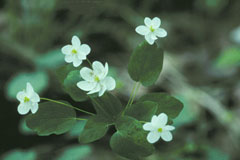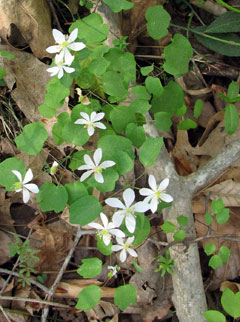 |
|
|
 |
| http://tolweb.org/onlinecontributors/app?page=ViewImageData&service=external&sp=24854 |
Translate this page:
Summary
Bloom Color: Pink.
Main Bloom Time: Early summer, Late spring, Mid spring. Form: Upright or erect.
Physical Characteristics

 Anemonella thalictroides is a PERENNIAL growing to 0.1 m (0ft 4in) at a slow rate.
Anemonella thalictroides is a PERENNIAL growing to 0.1 m (0ft 4in) at a slow rate.
See above for USDA hardiness. It is hardy to UK zone 4. It is in flower in April. The species is hermaphrodite (has both male and female organs).
Suitable for: light (sandy) soils and prefers well-drained soil. Suitable pH: mildly acid, neutral and basic (mildly alkaline) soils. It can grow in full shade (deep woodland) or semi-shade (light woodland). It prefers moist soil.
UK Hardiness Map
US Hardiness Map
Synonyms
Anemone thalictroides. Syndesmon thalictroides. Thalictrum anemonoides.
Plant Habitats
Woodland Garden Dappled Shade; Shady Edge; not Deep Shade;
Edible Uses
Edible Parts: Root
Edible Uses:
Root - cooked[46, 61, 222]. Starchy[105, 177]. Some caution is advised, see the notes above on toxicity.
References More on Edible Uses
Medicinal Uses
Plants For A Future can not take any responsibility for any adverse effects from the use of plants. Always seek advice from a professional before using a plant medicinally.
Astringent
A tea made from the roots is used in the treatment of diarrhoea and vomiting[222]. A preparation of the root has historically been used in the treatment of piles[222].
References More on Medicinal Uses
The Bookshop: Edible Plant Books
Our Latest books on Perennial Plants For Food Forests and Permaculture Gardens in paperback or digital formats.

Edible Tropical Plants
Food Forest Plants for Hotter Conditions: 250+ Plants For Tropical Food Forests & Permaculture Gardens.
More

Edible Temperate Plants
Plants for Your Food Forest: 500 Plants for Temperate Food Forests & Permaculture Gardens.
More

More Books
PFAF have eight books available in paperback and digital formats. Browse the shop for more information.
Shop Now
Other Uses
References More on Other Uses
Cultivation details
Landscape Uses:Massing, Rock garden, Woodland garden. Requires a moist shady light soil[1], it strongly resents any wetness at the roots[200]. A delicate plant for a loose leafy soil in sun or part shade[187]. Plants dislike any root disturbance, they should be planted in their final positions whilst still young[1]. A greedy plant inhibiting the growth of nearby plants, especially legumes[54]. Plants are slow to establish, often falling victim to slug predations[200]. Special Features:Attractive foliage, North American native.
References Carbon Farming Information and Carbon Sequestration Information
Temperature Converter
Type a value in the Celsius field to convert the value to Fahrenheit:
Fahrenheit:
The PFAF Bookshop
Plants For A Future have a number of books available in paperback and digital form. Book titles include Edible Plants, Edible Perennials, Edible Trees,Edible Shrubs, Woodland Gardening, and Temperate Food Forest Plants. Our new book is Food Forest Plants For Hotter Conditions (Tropical and Sub-Tropical).
Shop Now
Plant Propagation
Seed - best sown in a cold frame as soon as it is ripe in the summer. When large enough to handle, prick the seedlings out into individual pots and grow them on in the greenhouse for their first winter. Plant them out in the spring. Division - this is best done in the autumn by carefully removing pieces from the outside of the clump and growing them on in pots until they are established[1, 200]. Be careful to disturb the main clump as little as possible[1].
Other Names
If available other names are mentioned here
Native Range
NORTHERN AMERICA: Canada (Ontario), United States (Connecticut, Indiana, Maine, Massachusetts, Michigan, New Hampshire, New Jersey, New York, Ohio, Pennsylvania, Rhode Island, Vermont, West Virginia, Illinois, Iowa, Kansas, Minnesota, Missouri, Oklahoma, Wisconsin, Alabama, Arkansas, Delaware, Florida, Georgia, Kentucky, Louisiana, Mississippi, North Carolina, South Carolina, Tennessee, Virginia, District of Columbia)
Weed Potential
Right plant wrong place. We are currently updating this section.
Please note that a plant may be invasive in one area but may not in your area so it's worth checking.
Conservation Status
IUCN Red List of Threatened Plants Status :

Growth: S = slow M = medium F = fast. Soil: L = light (sandy) M = medium H = heavy (clay). pH: A = acid N = neutral B = basic (alkaline). Shade: F = full shade S = semi-shade N = no shade. Moisture: D = dry M = Moist We = wet Wa = water.
Now available:
Food Forest Plants for Mediterranean Conditions
350+ Perennial Plants For Mediterranean and Drier Food Forests and Permaculture Gardens.
[Paperback and eBook]
This is the third in Plants For A Future's series of plant guides for food forests tailored to
specific climate zones. Following volumes on temperate and tropical ecosystems, this book focuses
on species suited to Mediterranean conditions—regions with hot, dry summers and cool, wet winters,
often facing the added challenge of climate change.
Read More
Expert comment
Author
(L.)Spach.
Botanical References
43200270
Links / References
For a list of references used on this page please go here
Readers comment
| Add a comment |
|
If you have important information about this plant that may help other users please add a comment or link below. Only comments or links that are felt to be directly relevant to a plant will be included. If you think a comment/link or information contained on this page is inaccurate or misleading we would welcome your feedback at [email protected]. If you have questions about a plant please use the Forum on this website as we do not have the resources to answer questions ourselves.
* Please note: the comments by website users are not necessarily those held by PFAF and may give misleading or inaccurate information.
To leave a comment please Register or login here All comments need to be approved so will not appear immediately.
|
Subject : Anemonella thalictroides
|
|
|
|